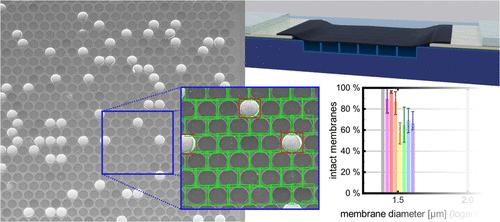High-Yield Large-Scale Suspended Graphene Membranes over Closed Cavities for Sensor Applications
IF 15.8
1区 材料科学
Q1 CHEMISTRY, MULTIDISCIPLINARY
引用次数: 0
Abstract
Suspended membranes of monatomic graphene exhibit great potential for applications in electronic and nanoelectromechanical devices. In this work, a “hot and dry” transfer process is demonstrated to address the fabrication and patterning challenges of large-area graphene membranes on top of closed, sealed cavities. Here, “hot” refers to the use of high temperature during transfer, promoting the adhesion. Additionally, “dry” refers to the absence of liquids when graphene and target substrate are brought into contact. The method leads to higher yields of intact suspended monolayer chemical vapor deposition (CVD) graphene and artificially stacked double-layer CVD graphene membranes than previously reported. The yield evaluation is performed using neural-network-based object detection in scanning electron microscopy (SEM) images, ascertaining high yields of intact membranes with large statistical accuracy. The suspended membranes are examined by Raman tomography and atomic force microscopy (AFM). The method is verified by applying the suspended graphene devices as piezoresistive pressure sensors. Our technology advances the application of suspended graphene membranes and can be extended to other two-dimensional materials.

用于传感器应用的封闭空腔上的高产大规模悬浮石墨烯薄膜
单原子石墨烯悬浮膜在电子和纳米机电设备中具有巨大的应用潜力。在这项工作中,展示了一种 "干热 "转移工艺,以解决在封闭的密封腔体顶部制造大面积石墨烯膜和图案化的难题。这里的 "热 "是指在转移过程中使用高温,以促进附着力。此外,"干 "是指石墨烯和目标基底接触时没有液体。与之前的报道相比,该方法可获得更高的完整悬浮单层化学气相沉积(CVD)石墨烯和人工堆叠双层 CVD 石墨烯膜的产量。产量评估是通过基于神经网络的扫描电子显微镜(SEM)图像中的物体检测来进行的,以较高的统计精度确定了完整膜的高产量。悬浮膜通过拉曼断层扫描和原子力显微镜(AFM)进行检测。通过将悬浮石墨烯器件用作压阻压力传感器,验证了该方法。我们的技术推进了悬浮石墨烯膜的应用,并可扩展到其他二维材料。
本文章由计算机程序翻译,如有差异,请以英文原文为准。
求助全文
约1分钟内获得全文
求助全文
来源期刊

ACS Nano
工程技术-材料科学:综合
CiteScore
26.00
自引率
4.10%
发文量
1627
审稿时长
1.7 months
期刊介绍:
ACS Nano, published monthly, serves as an international forum for comprehensive articles on nanoscience and nanotechnology research at the intersections of chemistry, biology, materials science, physics, and engineering. The journal fosters communication among scientists in these communities, facilitating collaboration, new research opportunities, and advancements through discoveries. ACS Nano covers synthesis, assembly, characterization, theory, and simulation of nanostructures, nanobiotechnology, nanofabrication, methods and tools for nanoscience and nanotechnology, and self- and directed-assembly. Alongside original research articles, it offers thorough reviews, perspectives on cutting-edge research, and discussions envisioning the future of nanoscience and nanotechnology.
 求助内容:
求助内容: 应助结果提醒方式:
应助结果提醒方式:


